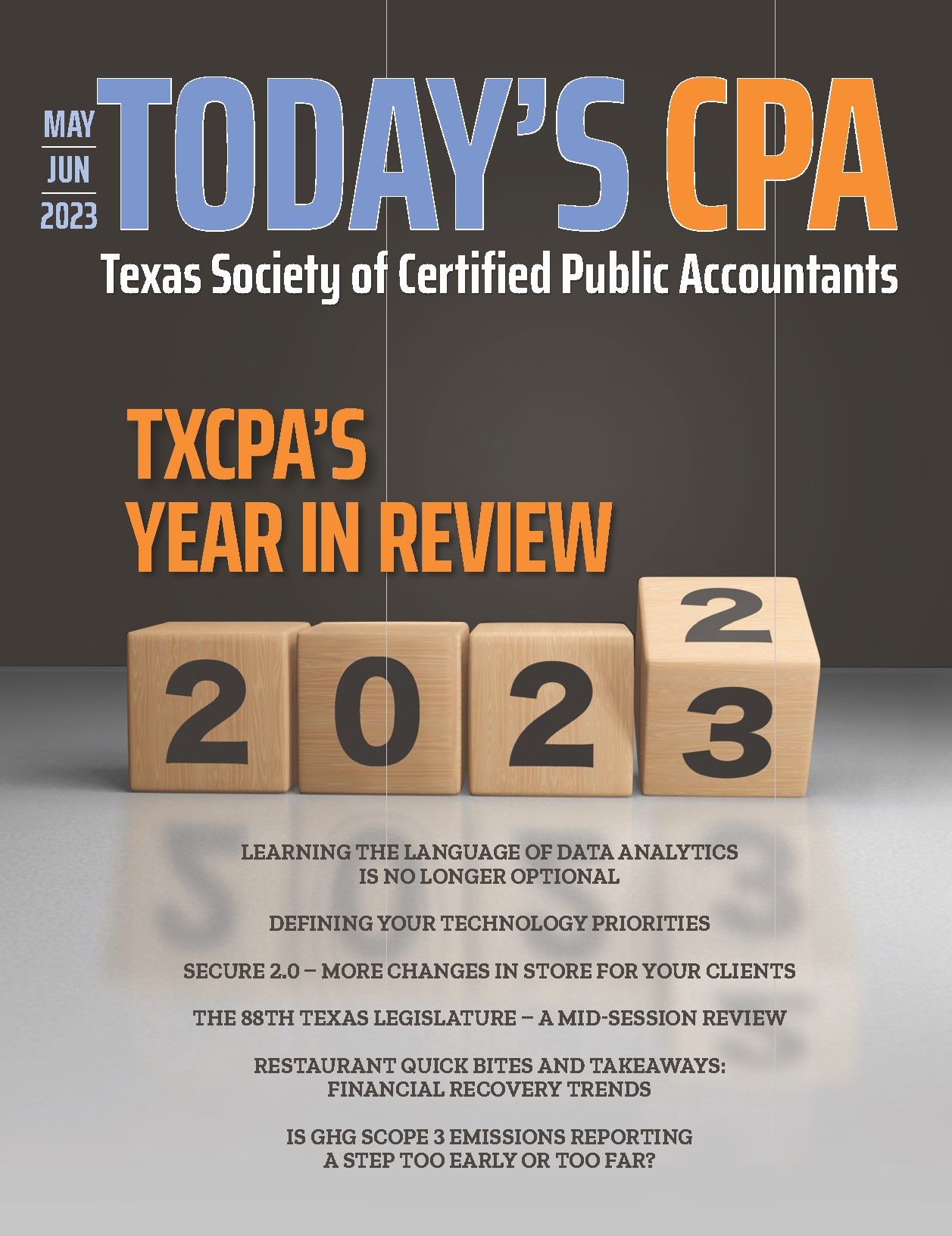Restaurant Quick Bites and Takeaways: Financial Recovery Trends
By Christa Jaganath
Restaurant operators just can’t catch a break as they navigate through the aftermath of the pandemic, brace for a possible recession and adapt to the fast-changing demands of consumers.
Challenges operators faced over the past few years include dealing with rising commodity prices, expanding drive-through lanes, implementing delivery and curbside services, limiting dining capacity and most importantly, facing a staffing crisis.
While operators have been able to capitalize on various relief funding, the future of the restaurant industry continues to be fragile, leaving many operators struggling to stay afloat.
Labor and food costs are two significant expenses for a restaurant. A study performed in early 2022 by the National Restaurant Association showed labor costs were up 8.6% and wholesale food costs were up 7.9% from 2020 to 2021.1
A majority of operators, 85%, say their restaurant is less profitable now than it was in 2019, before the pandemic.2 Learning to manage and plan ahead will be critical in improving margins and surviving the possible recession ahead.
Evolution of Restaurants
Technology and Innovation
More and more consumers are working from remote locations and preferences for drive-through and delivery services continue to vary alongside changing work habits. While the use of various delivery services
has been beneficial to consumers, the costs associated with using these platforms and the related commission payouts have left operators with minimal profits from each transaction. Some third-party services charge restaurants up to 30% in delivery,
order processing and other fees.3
Given consumers’ demands, it is not feasible to eliminate these delivery services; however, operators must begin thinking more long term and strategically about providing other avenues for customers to place orders, especially in an economy of staffing shortages and high labor costs.
Self-service kiosks, quick-service vending machines, robot delivery services, robot hosts and drones are possible options to help lower labor costs and manage staff turnover. In a survey performed by the National Restaurant Association, 64% of Generation Z adults (defined in the survey as born between 1996 and 2003) and 61% of millennials (born between 1980 and 1995) were open to having their food delivered by a drone.4
Technology and automation have proved to be reliable long-term tools for many operators and are changing the future of delivery and dine-in experiences. The need for delivery and curbside pickup is here to stay. How these services are performed in the future is expected to evolve. Operators are strategically evaluating technology services while prioritizing customer service and the quality of their food.
Food and Beverage Inflation Costs
Inflation costs have affected consumers in every area, including food and beverage. Costs from suppliers and imported goods have been unstable and rising throughout 2022 and 2023. The National Restaurant
Association reported an increase of 8.8% in full-service menu prices between September 2021 and September 2022. Grocery store prices increased 13% between September 2021 and September 2022.5 Operators might have no other choice but to push
some of these costs to consumers in various ways, including but not limited to the following.
Reevaluating menu options. Operators are evaluating food costs and narrowing menu options to eliminate lower-performing menu items. Managing inventory is critical to prevent spoilage and excess buying, and a limited menu assists with this effort. In addition, operators have increased menu prices to compensate for the increased cost in purchasing inventory.
Charging inflation recovery fees. Some operators are transparent with consumers by posting signage that communicates a fee is charged on each customer bill to assist with the pandemic recovery.
Passing on credit card fees. Credit cards, vendor pay apps and gift cards have become popular methods of payment. During 2021, credit card transaction fees accounted for $77.5 billion.6 Two major credit card companies account for a majority of the credit card network, which prevents operators from being able to negotiate or vendor shop. Operators are pushing these costs to consumers by charging a fee for credit card transactions or requiring a minimum purchase amount to be met before accepting credit card payments.
On July 28, 2022, the Credit Card Competition Act of 2022, which is intended to help decrease credit card fees by allowing more competition in the credit card processing network, was introduced in the U.S. Senate.7 An identical bill was introduced in the U.S. House of Representatives on Sept. 19, 2022.8 As of this writing, the act is pending review by committees in both houses of Congress.
Supply Chain Disruption
The past several years have brought supply shortages of a variety of goods, including toilet paper, chicken wings, mineral water, packaging and more. The costs of freight and taxes from imports continue to
increase as a result of delivery driver shortages, political turmoil overseas, weather disasters, and inability to manufacture and produce at the rate of consumer demand. Eight in 10 operators in a 2021 survey said they experienced supply delays or
shortages of equipment or service items.9
With these disruptions not expected to go away anytime soon, one of the biggest lessons from 2022 is learning to pivot and communicate. Restaurant operators are addressing these disruptions by limiting menu options or having a menu substitute on standby, increasing menu prices, and taking a forward-looking approach on inventory management.
Pre-pandemic, many operators relied on one or two suppliers for inventory purchases. Going forward, having a network of suppliers and sufficient supplier redundancy is key in supply management.
Financial Reporting Implications
With a recession expected, restaurants will need to continue to assess their ability to remain a going concern over the next 12 months. To do so, restaurant operators should look at financial and operational indicators such as:
- Working capital;
- Cash flows;
- Equity:
- Ability to meet obligations;
- Compliance with debt covenants;
- Loss in key suppliers or customers;
- Legal proceedings; and
- More.
When adverse indicators would have a negative impact on the restaurant operator, management should complete a going concern evaluation. Adequate disclosure must be included in the financial statements to document the indicators and the company’s plan to mitigate the risk. Further guidance on management’s assessment can be found under Financial Accounting Standards Board Accounting Standards Codification 205-40-50-4.
As restaurant operators turn to technology for assistance, capitalized asset purchases are expected to increase. On financial statements, these assets are depreciated over time. The tax benefit of acquiring new equipment and technology is the ability to qualify for a tax deduction on qualifying equipment and software. However, operators will need to continue to evaluate assets for impairment.
For multiunit operations, this evaluation includes assessing the performance of each location and determining if the future cash flows generated from the use of those assets exceed the book value on the financials. For lower-performing locations, this might require a deeper dive into an impairment analysis. It is critical for operators to closely monitor each location and make strategic decisions to either enhance profitability or exit markets that are underperforming.
Big Decisions Ahead
Restaurant operators have big decisions and investments to make to keep up with the financial trends in 2023. Government programs such as the Paycheck Protection Program and Restaurant Revitalization Fund were temporary bandages
to help small businesses get through the past few years. Even so, many restaurants were unable to make it out of the pandemic.
With no substantial government funding expected in the coming months, operators need to monitor margins closely, stay up to speed with accounting and tax implications, and strategize about reducing operational costs.
About the Author: Christa Jaganath is a managing director at Crowe, specializing in restaurants and consumer markets. She is an active member of the Texas Restaurant Association and serves on the board of the Greater Houston Restaurant Association. She may be contacted at christa.jaganath@crowe.com or 713-366-8534.
Footnotes
“2022 State of the Restaurant Industry.”
National Restaurant Association, 31 Jan. 2022, .
“Bottom Line Impact of Rising Costs for Restaurants.”
National Restaurant Association, 24 Aug. 2022, Oden, Garrett.
“Demystifying Delivery App Fees for Restaurants.”
Lunchbox, 12 May 2022, National Restaurant Association. National Household Survey, 2021.
“Menu Prices.”
National Restaurant Association, accessed 1 Nov. 2022,
“Policy Brief: Credit Card Competition Act of 2022,”
National Restaurant Association, 12 Sept. 2022, .
S.4674 – Credit Card Competition Act of 2022
H.R.8874 – Credit Card Competition Act of 2022
“Supply Chain Shortages Still Affecting Industry,” National Restaurant Association, 13 Jan. 2022

















